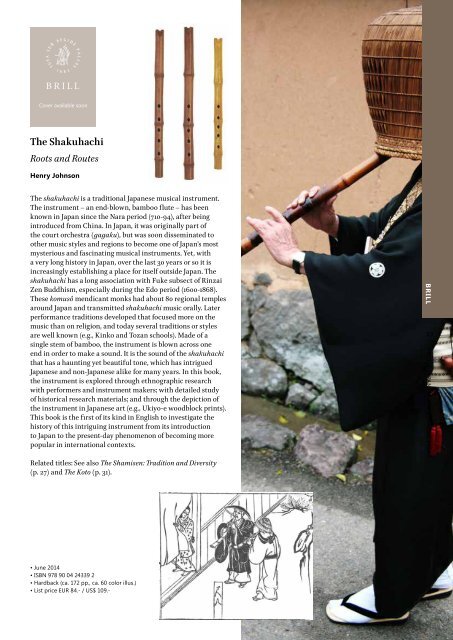japanese_art_catalog
japanese_art_catalog
japanese_art_catalog
You also want an ePaper? Increase the reach of your titles
YUMPU automatically turns print PDFs into web optimized ePapers that Google loves.
Cover available soon<br />
The Shakuhachi<br />
Roots and Routes<br />
Henry Johnson<br />
The shakuhachi is a traditional Japanese musical instrument.<br />
The instrument – an end-blown, bamboo flute – has been<br />
known in Japan since the Nara period (710-94), after being<br />
introduced from China. In Japan, it was originally p<strong>art</strong> of<br />
the court orchestra (gagaku), but was soon disseminated to<br />
other music styles and regions to become one of Japan’s most<br />
mysterious and fascinating musical instruments. Yet, with<br />
a very long history in Japan, over the last 30 years or so it is<br />
increasingly establishing a place for itself outside Japan. The<br />
shakuhachi has a long association with Fuke subsect of Rinzai<br />
Zen Buddhism, especially during the Edo period (1600-1868).<br />
These komusô mendicant monks had about 80 regional temples<br />
around Japan and transmitted shakuhachi music orally. Later<br />
performance traditions developed that focused more on the<br />
music than on religion, and today several traditions or styles<br />
are well known (e.g., Kinko and Tozan schools). Made of a<br />
single stem of bamboo, the instrument is blown across one<br />
end in order to make a sound. It is the sound of the shakuhachi<br />
that has a haunting yet beautiful tone, which has intrigued<br />
Japanese and non-Japanese alike for many years. In this book,<br />
the instrument is explored through ethnographic research<br />
with performers and instrument makers; with detailed study<br />
of historical research materials; and through the depiction of<br />
the instrument in Japanese <strong>art</strong> (e.g., Ukiyo-e woodblock prints).<br />
This book is the first of its kind in English to investigate the<br />
history of this intriguing instrument from its introduction<br />
to Japan to the present-day phenomenon of becoming more<br />
popular in international contexts.<br />
BRILL<br />
13<br />
BRILL’S JAPANESE ART CATALOG 2014<br />
Related titles: See also The Shamisen: Tradition and Diversity<br />
(p. 27) and The Koto (p. 31).<br />
• June 2014<br />
• ISBN 978 90 04 24339 2<br />
• Hardback (ca. 172 pp., ca. 60 color illus.)<br />
• List price EUR 84.- / US$ 109.-






